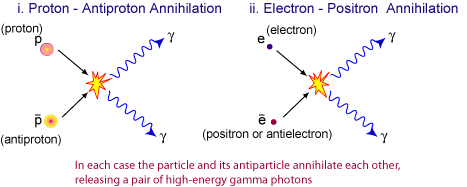danshawen
Valued Senior Member
It is an excellent post, and I do not discount it.
A photon probably isn't energy in its purest form either. It does have spin (polarization), and it carries inertia in a single direction if it is not polarized. But it does travel faster than anything else in a vacuum because it has zero mass.
Protons are made of two up and one down quarks, partons, aces, or whatever, gluons as bosoms of the strong nuclear force exchanging color charge between them, various mesons, possessing a positive charge that exactly counterbalances that of an electron. Because of this last characteristic, and if you believe as I do in the Standard Model, photons are the EM bosons that bind the nucleus to the electron shell. It isn't all photons then, right?
When a proton meets an antiproton, you decompose a proton into an electron, a neutron, and an electron anti neutrino. James R already covered what happens when an electron meets a positron. The atom of positronium quickly decays into a pair of gamma photons. Sorry guys, but that looks like the whole of atomic structure is made of energy to me.
Then we discovered that the Higgs boson, a chunk of the vacuum, also sometimes rapidly decomposed into gluons, or sometimes into a pair of electrons, or sometimes into electroweak bosons. Every component of atomic structure.
And we also just discovered evidence of a previously missed fifth force in atomic structure that doesn't even have its own term in the Lagrangian yet. Even the Higgs had a placeholder for that before July 2012.
If you tell me that you don't believe that at its most fundamental level, E=mc^2 doesn't mean exactly what it says, I say someone simply isn't paying very much attention. That relationship was derived of the inertia of a photon. I suppose 1905 was a very long time ago. That is a very long life for a theory whose time to be extended is now upon us.
A photon probably isn't energy in its purest form either. It does have spin (polarization), and it carries inertia in a single direction if it is not polarized. But it does travel faster than anything else in a vacuum because it has zero mass.
Protons are made of two up and one down quarks, partons, aces, or whatever, gluons as bosoms of the strong nuclear force exchanging color charge between them, various mesons, possessing a positive charge that exactly counterbalances that of an electron. Because of this last characteristic, and if you believe as I do in the Standard Model, photons are the EM bosons that bind the nucleus to the electron shell. It isn't all photons then, right?
When a proton meets an antiproton, you decompose a proton into an electron, a neutron, and an electron anti neutrino. James R already covered what happens when an electron meets a positron. The atom of positronium quickly decays into a pair of gamma photons. Sorry guys, but that looks like the whole of atomic structure is made of energy to me.
Then we discovered that the Higgs boson, a chunk of the vacuum, also sometimes rapidly decomposed into gluons, or sometimes into a pair of electrons, or sometimes into electroweak bosons. Every component of atomic structure.
And we also just discovered evidence of a previously missed fifth force in atomic structure that doesn't even have its own term in the Lagrangian yet. Even the Higgs had a placeholder for that before July 2012.
If you tell me that you don't believe that at its most fundamental level, E=mc^2 doesn't mean exactly what it says, I say someone simply isn't paying very much attention. That relationship was derived of the inertia of a photon. I suppose 1905 was a very long time ago. That is a very long life for a theory whose time to be extended is now upon us.

